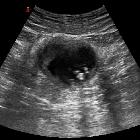retained gallstone



Retained gallstones, also called dropped or slipped gallstones, are common during a laparoscopic cholecystectomy, with a reported incidence of 0.1–20%, and occur when gallstones are inadvertently spilled into the peritoneal cavity.
Clinical presentation
Many cases of dropped gallstones will be asymptomatic. However, patients may become symptomatic if a complication develops and may present with infective symptoms, pain or fistula (e.g. colovesical fistula) formation.
Pathology
Perforation of the gallbladder during surgery may release a gallstone into the peritoneal cavity. Abscess and fistula formation are possible as a result of the stone. The risk of abscess formation is greater in the setting of dropped pigment stones as the majority of pigment stones contain bacteria .
Radiographic features
CT
Dropped gallstones may have the following appearances on CT :
- initially calcified stones may appear as one or multiple hyperdense foci in Morrison's pouch, the gallbladder fossa and the pelvis
- cholesterol or pigmented stones may be more difficult to appreciate
- local abscess or fistula formation may also be evident in some cases
MRI
MRI appearance depends on the composition of the stone .
Pigmented stones appear as:
- T1: hypertense
Other types of stones appear:
- T1: hypointense
- T2: hypointense
Stones do not show enhancement with contrast.
Treatment and prognosis
The dropped stone will generally need to be removed if it is causing complications (e.g. abscess formation).
Differential diagnosis
Consider the following :
- peritoneal loose bodies
- peritoneal metastases: dropped stones may resemble metastatic disease or lymph nodes however the presence of dense calcifications generally favors a dropped stone
- colonic diverticulum
- dropped appendicolith
See also
Siehe auch:

 Assoziationen und Differentialdiagnosen zu retained gallstone:
Assoziationen und Differentialdiagnosen zu retained gallstone:

